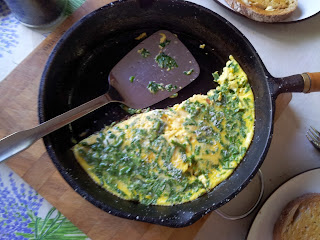 |
| A piece of art - early autumn salad |
The final days of February see us roll with increasing haste to shorter days and cooler nights - a vegetable garden is a real indicator of seasonal change. The tomatoes we planted in October are no longer producing their dainty golden flowers, the original cucumber plants are wilting and looking their age and the asparagus no longer shoots up its tender spears. The lettuce and spring onions are however finding their stride.
One of the new vegetables to harvest now are potatoes. Three months ago we planted a dozen potatoes and the harvest was the basis for this month's peasant meal.
Potato frittata and early autumn salad
The early autumn salad is a palate of lime greens, bright burnt orange and sunny yellow. Peppery nasturtium flowers create a splash of colour against mini cos lettuce, mellow yellow tomatoes, Japanese cucumber and bush beans. Almost a piece of art.
The frittata
Dice 4 good sized potatoes into small chunks and steam until soft. Fry in an oiled medium sized pan with a couple of cloves of garlic until golden. Add a couple of handfuls of silverbeet and cook for a couple of minutes until wilted. Whisk together 4 egg yolks and 2 egg whites with lots of freshly cracked pepper. Pour eggs into pan with potatoes and cook over medium heat until the sides of the frittata are set - about 5 minutes. The centre will still be runny. Put under a grill for a few minutes. Sprinkle with some grated cheese and put under the grill for another couple of minutes. Cut and serve from the pan.







